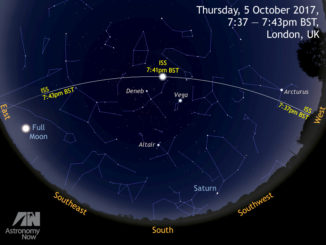
The surface of Enceladus (313 miles or 504 kilometres across) endures a constant rain of ice grains from its south polar jets. As a result, its surface is more like fresh, bright, snow than Dione’s (698 miles or 1123 kilometres across) older, weathered surface. As clean, fresh surfaces are left exposed in space, they slowly gather dust and radiation damage and darken in a process known as “space weathering.”
This view looks toward the leading hemisphere of Enceladus. North on Enceladus is up and rotated 1 degree to the right. The image was taken in visible light with the Cassini spacecraft narrow-angle camera on 8 September 2015.
The view was acquired at a distance of approximately 52,000 miles (83,000 kilometres) from Dione. Image scale is 1,600 feet (500 metres) per pixel. The distance from Enceladus was 228,000 miles (364,000 kilometres) for an image scale of 1.4 miles (2.2 kilometres) per pixel.



